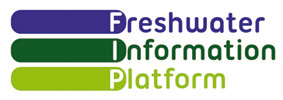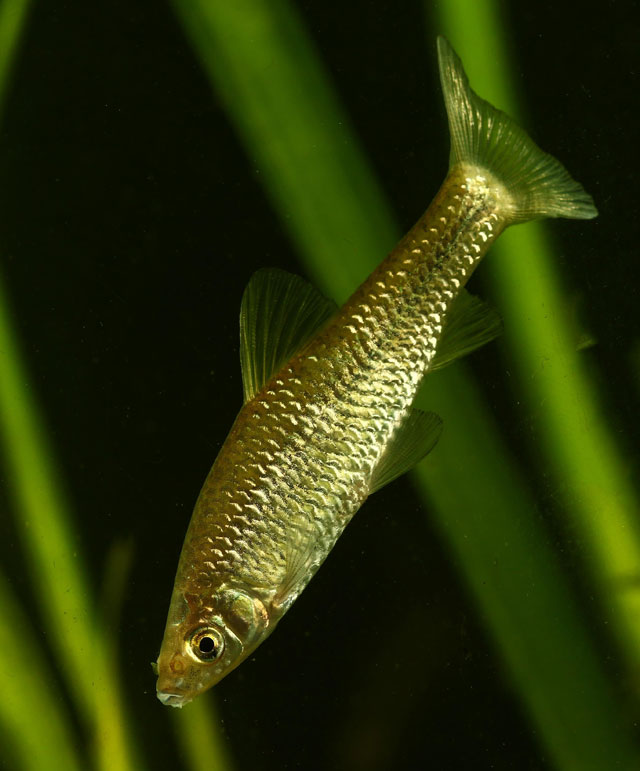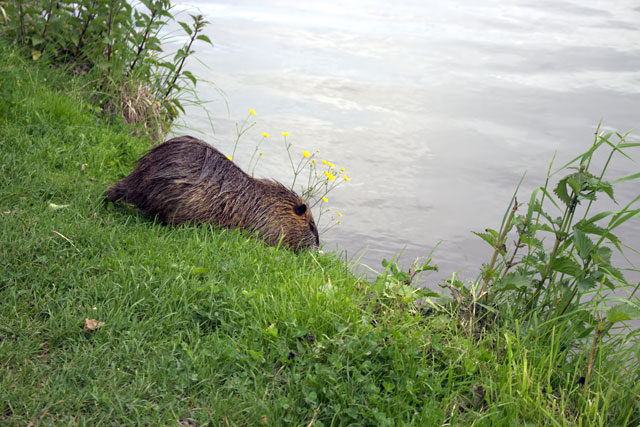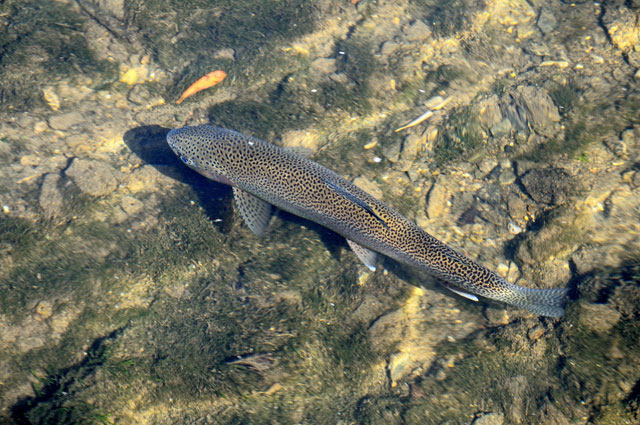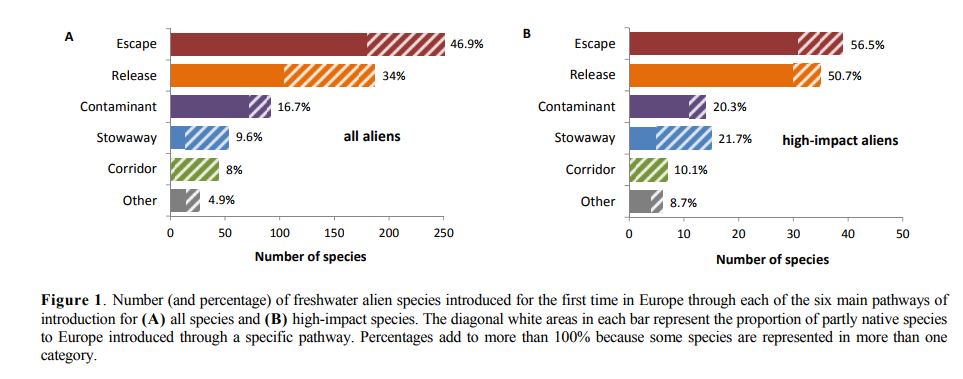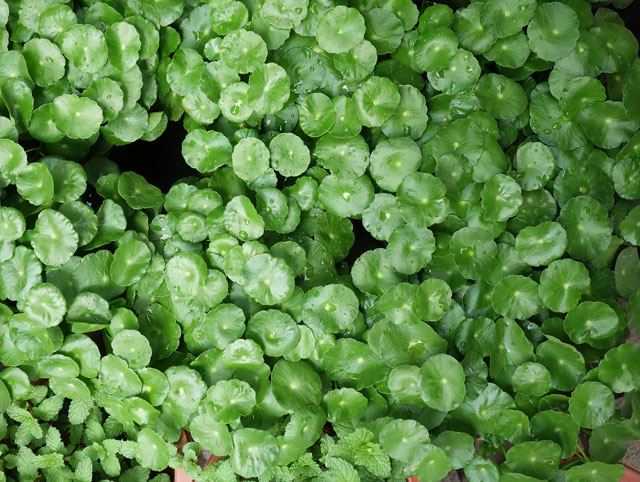Introduced species and diseases
Invasive alien species (IAS) are plants and animals that have been introduced beyond their natural geographical range, whether deliberately (e.g. for food, the pet trade or sport fishing) or accidentally (e.g. through transport networks). Prominent European freshwater invasives include the floating pennywort (Hydrocotyle ranunculoides), the topmouth gudgeon (Pseudorasbora parva) and the American signal crayfish (Pacifastacus leniusculus).
The spread of IAS is one of the key pressures on freshwater biodiversity and ecosystem service provision in Europe, due to competition for habitat, predation, habitat alteration, species hybridisation and introduced diseases (EEA 2012a). Once established, IAS are often difficult or impossible to control, making their presence and spread a widespread pressure on the ecological status of water bodies in Europe. Whilst some IAS can bring economic benefits to specific sectors of society (and others are largely benign), their presence is often harmful to human livelihoods: the economic damage caused by IAS to European agriculture, forestry and fisheries is estimated to be more than €12 billion per year (EEA 2012b).
Pressure types
Habitat competition – IAS may out-compete native species for habitat and food. For example, the spread of the aggressive, ecologically-generalist American mink originally farmed for fur has been shown to negatively impact native European mink and European polecat populations in freshwaters and transitional waters across Northern Europe (EEA 2012a).
Habitat alteration – IAS colonisation can alter the forms and functioning of freshwater ecosystems. For example, the coypu – a large rodent native to South America and introduced to Western Europe through the fur trade – digs extensive burrows in and around river banks, dykes and levees, which can disrupt flood protection and drainage systems and cause erosion and siltation in water bodies (EEA 2012a).
Predation – IAS may predate on native species in colonised ecosystems. For example, the common slider – a large freshwater turtle popular in the pet trade – is an opportunistic predator, shown to voraciously feed on a range of plants, mammals, fish, insects and birds in colonised water bodies across Southern and Western Europe (EEA 2012a).
Hybridisation – Some IAS may breed with native species, potentially leading to alterations in adaptations, resilience and genetic diversity in local populations. For example, the North American brook trout introduced to water bodies across Northern, Western and Southern Europe for sport fishing may hybridise with native brown trout, potentially leading to populations losing local ecological adaptations, and being unable to reproduce (EEA 2012a)
Introduced diseases – IAS may introduce diseases to which local species populations are vulnerable. For example, Batrachochytrium dendrobatidis (or Bd) is a pathogenic microscopic fungus responsible for chytridiomycosis, an infectious disease which is deadly to amphibian species, and has been documented across Europe, with its spread linked to amphibians introduced through the global pet trade (EEA 2012a).
Geographical distributions and trends
European lake and river ecosystems currently contain around 300 invasive freshwater invertebrates species and more than 130 invasive fish species, and trends indicate that IAS species and populations are likely to increase in coming years in a increasingly interconnected world with a changing climate (EEA 2012b). Whilst different invasive species will tend towards different habitat types, the broad geography of freshwater IAS populations in Europe is linked to pathways for their introduction: transport hubs such as docks and harbours, urban populations when pet ownership is high, sport fishing water bodies and fur and fish farms (EEA 2012a). As such, the prevalence of invasive species can vary on a national scale, depending on local colonisation pathways and management: for example where 56 % of rivers and 11 % of lakes in the Thames river basin district in Southern England are impacted by the presence of IAS, less than 1% of Scottish surface waters are affected (EEA 2012b).
Stressors generated
The stressors generated by introduced species and disease pressures are dependent on the individual species and habitats, but are commonly biological (e.g. the Bd disease in amphibians, predation by brook trout) or morphological (e.g. the alteration of habitats by zebra mussels or copyu). The blanket spread of invasive plant species (e.g. floating pennywort) has the potential to cause thermal and hydrological stress to aquatic ecosystems through shading and flow alterations.
Potential for mitigation
Whilst invasive species requires tailored management strategies to mitigate their individual ecological impacts, a ‘toolkit’ of common measures includes: preventive measures to stop the spread of IAS; early detection systems coupled with rapid response protocols to stem new introductions; and trapping and eradication management to remove existing populations (EEA 2010). Such measures are supported politically by the EU Biodiversity Strategy to 2020 (Target 5), and the Convention on Biological Diversity Aichi Biodiversity (Target 9) which together aim to control or eradicate IAS and their pathways for introduction by 2020.
Further reading
Reports and publications:
EEA (2010). Towards an early warning and information system for invasive alien species (IAS) threatening biodiversity in Europe (Download report, 2mb)
EEA (2012a). The impacts of invasive alien species in Europe (Download report, 25.5mb).
EEA (2012b). European waters - assessment of status and pressures (Download report, 28mb)
Nunes A.L., Tricarico E., Panov V.E., Cardoso A.C. & S. Katsanevakis (2015). Pathways and gateways of freshwater invasions in Europe, Aquatic Invasions, Vol. 10 (4): 359–370. DOI: 10.3391/ai.2015.10.4.01 (Download article, 1.5mb)
Selected Freshwater blogs:
Freshwaterblog (2012). Regulating trade may hold key to stopping spread of deadly amphibian disease (External website)
Freshwaterblog (2016). Invasion of the Swamp Monster (External website)
Other websites:
European Alien Species Information Network (External website)

